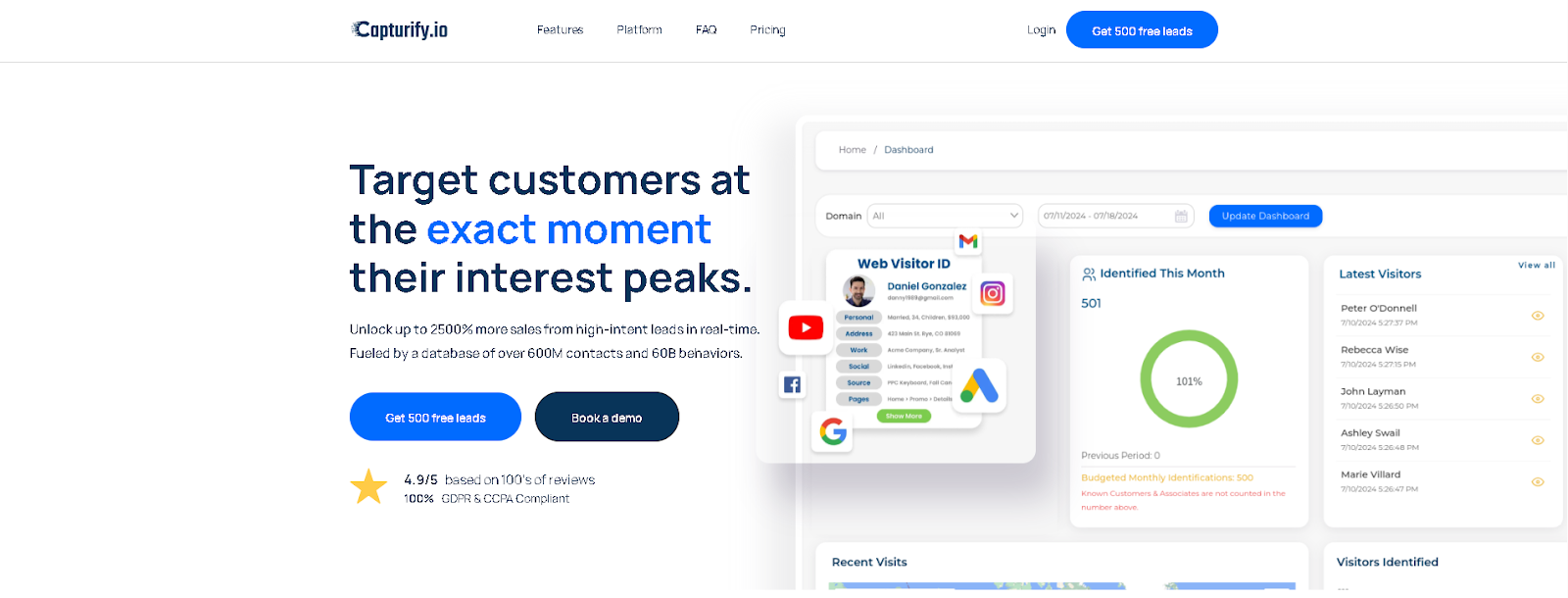Finding the right customers isn’t easy. You spend time and money attracting visitors, but most leave without buying.
That’s where prospecting and retargeting come into play.
Prospecting helps you reach new audiences, or people who haven’t interacted with your brand yet but fit your target market. Retargeting, on the other hand, focuses on potential customers who’ve already visited your site, clicked an ad, or shown interest but didn’t convert.
Used separately, each tactic plays a role. But combined in a cohesive strategy, retargeting and prospecting campaigns can dramatically improve conversion rates, maximize ad spend, and increase brand recognition.
Interested? This guide is for you.
What Is Prospecting?
Prospecting involves initiating contact with potential customers who are not yet familiar with your brand. It’s the first step in generating new leads and targeted leads by expanding awareness and filling the top of your sales funnel.
You run prospecting campaigns using Google Ads, social media platforms, and programmatic advertising to display ads to new audiences. These prospecting ads target users based on interests, behaviors, and demographics, often using lookalike audiences built from existing customers.
What Is Retargeting?
While prospecting focuses on new visitors, retargeting, also known as remarketing, engages users who have previously interacted with your brand but haven’t yet converted. These include people who’ve browsed your site, expressed interest by clicking your ads, or even abandoned carts.
Retargeting ads appear across the web, on social platforms, and through email marketing, using online behavior to serve relevant ads at just the right time.
Retargeting vs Prospecting: Key Differences
While they often work side by side, prospecting and retargeting serve very different purposes in your digital marketing strategy. Understanding how they differ helps you build more effective, efficient marketing campaigns.
Audience Targeting
Prospecting campaigns aim at new audiences who have never interacted with your brand. These users are completely cold but carefully selected through behavioral targeting, lookalike audiences, and digital profiles.
Retargeting campaigns, on the other hand, focus on potential customers who’ve already engaged with your business via website visits, ad clicks, or product views, but haven’t yet converted. It’s about staying top of mind for the users closest to converting.
Marketing Objective
The goal of prospecting is to build brand awareness and introduce your product or service to the right target market. It fills the top of your sales funnel.
Retargeting, by contrast, is designed to increase conversion rates by re-engaging users who already showed interest. It plays a crucial role in the later stages of the buying journey, helping serve relevant ads that guide users toward action.
Channels and Placement
Prospecting ads commonly run on search engines, social media channels, and programmatic advertising platforms. They focus on reaching fresh prospects where they’re actively browsing or searching.
Retargeting ads appear on social media, across the web, and in email marketing. They’re triggered by specific online behaviors, such as a product page view or site abandonment, and help extend the customer journey beyond the first touchpoint.
Budget and Cost Efficiency
Because prospecting targets a cold audience, the cost per click (CPC) is typically higher. There’s more spend involved in generating awareness among unfamiliar users.
Retargeting, however, is more cost-effective. It focuses on interested targets who already recognize your brand, making it cheaper to re-engage and more likely to produce quality leads while enhancing customer lifetime value and increasing conversions.
Performance and Conversion Rates
In general, retargeting campaigns outperform prospecting ads when it comes to conversion. Users who have previously interacted with your site are more likely to act, making retargeting a key tool for recovering potential leads.
That said, prospecting is essential for scale, as it introduces your brand to new customers, fueling the long-term growth of your customer base and setting the stage for retargeting later.
How Prospecting and Retargeting Work Together in the Sales Funnel
Prospecting and retargeting aren’t standalone tactics. They’re complementary forces that power different stages of your sales funnel.
A successful digital marketing strategy uses both to guide your target audience from discovery to conversion.
Here's how.
Prospecting Fuels the Top of the Funnel
At the awareness stage, prospecting campaigns introduce your brand to new customers who’ve never interacted with you before. These prospecting audiences are built using lookalike data sets, behavioral traits, or shared pain points. The goal is to generate leads from target users similar to your existing customer base.
This stage is about expanding reach, driving website traffic, and identifying the specific groups most likely to engage with your offer.
Retargeting Captures Mid- and Bottom-Funnel Conversions
Once visitors engage, whether they browse landing pages, abandon carts, or watch videos, retargeting and prospecting begin to diverge. Remarketing campaigns use behavioral signals and previous interactions to serve relevant content to people already familiar with your brand.
Retargeting campaigns aim for precise targeting, focusing on converting leads who showed intent but didn’t act. Because these users are already warm, the result is higher customer lifetime value and more efficient conversion.
Why Balancing Retargeting With Prospecting Matters
Focusing only on retargeting limits scale. You’ll exhaust your warm leads without replenishing your funnel. On the other hand, over-investing in prospecting without follow-up can lead to neglecting the most interested targets and ultimately waste ad spend.
The right balance means pairing outreach to new audiences with follow-up ads that build relationships and recover the most interested targets.
Real Campaign Example
Imagine you launch prospecting ads on social media that introduce a product to a broad but qualified audience. A percentage clicks through and visits your landing page.
Later, retargeting ads follow these users across social media channels and platforms, using a personalized approach to re-engage them with testimonials, discounts, or case studies.
Together, these campaigns guide users through the same stage of the buying journey, moving from awareness to decision without losing momentum.
How to Optimize Prospecting and Retargeting for Precision and ROI
Precision drives performance. Without a focused strategy, even the best retargeting practices and prospecting campaigns can fall flat.
To achieve real return on investment, you need to optimize your marketing efforts at every stage of the funnel, starting with how you define and engage your target audience.
1. Refine Audience Targeting With Data-Driven Segmentation
Not all visitors or potential buyers behave the same. Use behavioral insights, first-party data, and performance signals to segment your target audience.
For prospecting, focus on building lookalike audiences based on high-lifetime-value (LTV) customers or intent-driven behavior. For retargeting, segment by engagement level, cart abandoners, product viewers, or repeat site visitors, to tailor creative campaigns and improve timing.
2. Align Creative Content and Messaging to Intent
The copy and visuals in your prospecting campaigns should educate, attract, and highlight your brand’s value proposition and solve a clear problem.
For retargeting, for example, emphasize trust and urgency with social proof, limited offers, or reminders tied to previous interactions.
3. Adjust Frequency and Timing Strategically
Too many impressions can irritate users. Too few, and your message gets lost.
Use frequency caps, suppression windows, and timed sequences to make sure that many users see your content often enough to convert, but not so much that they tune out.
4. Measure What Moves the Needle
Track metrics beyond clicks. For retargeting and prospecting, measure conversion rate, engagement depth, and revenue lift.
Don’t just ask "Did they click?"; ask, "Did this audience move down the funnel?" A successful prospecting strategy not only brings in new traffic but also contributes to sales pipeline growth over time.
Maximize Prospecting and Retargeting Performance With Capturify

If you're running prospecting and retargeting campaigns but struggling to connect the dots, Capturify can change everything.
It's a powerful identity resolution tool designed to help brands identify anonymous website visitors and turn them into qualified prospects, so you can drive more conversions from every stage of the funnel.
Capturify doesn’t just track website traffic but also identifies users, builds digital profiles, and enriches data with actionable insights. That means when a new visitor lands on your page, you’re no longer blind to who they are.
This transforms one-time visits into qualified entries in your prospecting audience. Instead of relying only on ad platforms, your team can launch prospecting campaigns based on verified interest, which gives your brand full control over how and when to engage.
Prospecting and Retargeting Done With Precision, Not Just Pixel Data
Most retargeting and prospecting efforts rely on shallow pixel-based tracking. Capturify goes further.
It matches previous interactions, like landing page visits, abandoned forms, or product interest, with enriched identity data. This enables remarketing campaigns that are not only timely but also personalized and context-aware.
Capturify helps your marketing efforts stay aligned across channels. By centralizing your customer base insights across email, paid media, and organic touchpoints, it supports a full-funnel approach where prospecting campaigns feed directly into retargeting workflows.
This personalized approach boosts customer LTV by building real relationships instead of disconnected ad impressions.
Find new customers, reconnect with potential leads, and scale with precision today. Get started with 500 free leads!
FAQs About Prospecting and Retargeting
What is prospecting vs retargeting?
Prospecting targets new users who haven’t interacted with your brand before, aiming to drive awareness and traffic. Retargeting, on the other hand, focuses on users who have previously engaged with your site or content but didn’t convert.
While prospecting expands your audience, retargeting helps recover missed opportunities.
What is prospecting and remarketing?
Prospecting and remarketing are complementary digital strategies. Prospecting campaigns aim to attract new visitors from a broad or lookalike target audience. Remarketing (also called retargeting) re-engages users who have already shown interest, turning their previous interactions into conversion opportunities.
What is the difference between targeting and retargeting?
Targeting refers to delivering ads to a defined target audience, typically people who haven’t engaged with your brand yet. Retargeting focuses on users who have interacted with your content, website, or ads and helps guide them further along the customer journey.
What does prospecting mean in ads?
In advertising, prospecting means using campaigns, like social media ads or the Google Display Network, to introduce your brand to potential customers. These ads often use demographic, behavioral, or lookalike audience data to generate leads from scratch and fuel the top of your sales funnel.






.avif)